

 |
 |
||||
| Home | Reviews | Extras | Forums |
|
GeGeGe no Kitaro (2018) - Episode 1-49SynopsisLiving in the shadows of the human realm, the yokai are a mostly invisible, but still prominent part of the world. A lot of them are basically harmless, but in some cases, a human disappearance can leave people distraught and searching for answers. So, what can one do? As legends go, you can find the yokai mail box and send a letter to Kitaro, the resident of Yokai forest, and maybe he'll even help you solve your problem. ReviewShounen fatigue aside, it's a strange thing to be a newbie in a show franchise that is on its sixth incarnation! Which is to say that I don't know what the earlier versions of GeGeGe no Kitaro is about beyond its "human/yokai relationships" and the more general angle of "modern society is fine and all, but don't use that to trample all over more traditional values and norms because of them". But this newest incarnation, barely two years old, feels enough like a standalone thing that I seriously doubt you have to watch the earlier five shows to understand what's going on in this latest entry. 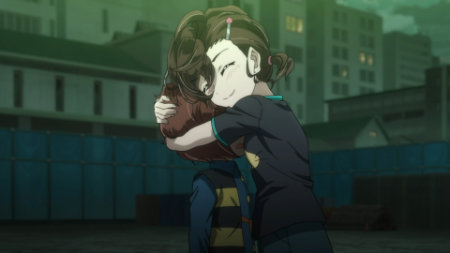 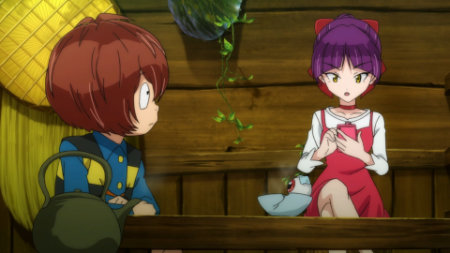 To be honest, it would actually be kind of interesting to see these earlier incarnation, even if they tended to reach terrifyingly large episodes numbers as well; the 1985 and 2007 episodes reaching -- if not even passing 100 episodes in length, and even the original 1968 show turned in an episode count of 65. In many ways, Kitaro reminds me a lot of Leiji Matsumoto's lead characters, although the 2018 incarnation certainly lessens the potatohead aspect to his character design. While I can't speak for said incarnations' personalities, 2018 Kitaro is a pretty laidback character at most times. However, get on his bad side, and you will most likely find out how terrifying he can be. Much like most of the residents of Yokai Forest, where you can find his house, Kitaro is a yokai, albeit a very human-looking one. That isn't specifically a rarity among yokai, though, even if many of them have giveaway traits that betray their yokai -- or, in some cases, half-yokai -- origins. There is a certain similarity to shoujo mainstay Natsume's Book of Friends to be found in GeGeGe no Kitaro, mostly in the way it portrays the many different yokai characters. Most importantly how many of them simply don't mix well with human beings, for many different reasons, and many of the episodes are centered around human/yokai pairings who tried to make it work, some of which even were allowed to meet with a modicum of success. However, unlike Natsume's Book of Friends, GeGeGe no Kitaro's approach to its stories take a more classic, shounen-ish bent, albeit probably a good deal less fight-happy than your average shounen. The main difference between Natsume's Book of Friends and GeGeGe no Kitaro -- and this probably has something to do with the original being a 52 year old show at this time, meaning this very show being a 50 year anniversary edition of the original TV show -- is that GeGeGe no Kitaro does deal with a lot of old folklore and the supernatural beings involved in said folklore. I am going to have to claim ignorance when it comes to most of these beings, but the show helpfully introduces them by name for those who want to do a little research, and even does a short explanation of what they are known for when it comes to some of the more eccentric ones. Then again, the main thing about yokai in Natsume's Book of Friends was that most humans couldn't see the yokai that more or less lived alongside them; it would take a certain level of spiritual powers to do so, or, lacking that, spells or techniques developed by people who had obtained enough knowledge about it. In GeGeGe no Kitaro, however, all the yokai could be seen by anyone at any point, unless said yokai made efforts not to be seen -- insert Monty Python jokes as you like -- either by being stealthy or, if they were strong enough, just making themselves invisible. The main theme of GeGeGe no Kitaro seems to be that people should hold the "old ways™" in respect more than... well, most people tend to do in this modern society. This is part of the reason why I'm a bit curious about the older shows, because this newest series does incorporate a lot of modern culture and technology, like smartphones and streaming services. I wonder what kind of issues the 1968 version would showcase, since I imagine a lot of people who lived through 1968 might think the people who didn't are being disrespectful towards that era as well, yet I imagine the 1968 show did the same to the people who were old enough to understand what made that era tick. Does that give the show an extra dimension? Now, that doesn't mean this current incarnation of GeGeGe no Kitaro dismisses said aspects of modern culture. Neko Musume obtains her own smartphone courtesy of her friendship with Mana, and it's generally portrayed as a helpful tool as long as it doesn't make you completely ignore the world around you. It's more that the subject leans more towards not taking things too far, whether that be fame, overreliance on tools, or even dwelling too much in the past, and that balance is what makes GeGeGe no Kitaro so appealing. Rather, GeGeGe no Kitaro's message seems to say that -- much like the relationship between yokai and human beings can work out with some common ground, so can traditions and progress. It goes hand in hand with how a lot of the characters are modernized to a relatively noticeable degree, although keeping in with the original designs. Kitaro himself is probably the one who's both changed the most and the least in the same time. His current incarnation suffers nearly none of the original potatohead, but he otherwise looks exactly the same when it comes to his articles of clothing to his hairstyle, which covers up one of his eyes. Yet his new design is definitely more conventionally attractive than his earlier look. The same can not be said about Neko Musume, sometimes referred to as "Cat Chick" by the subtitles. If you take a look at her Wikipedia page -- or WiKitaro page, if you will -- you'll see her going from a curiously hunched-over child with narrow cat-like eyes into a slender, leggy beauty, although arguably only her 2018 incarnation look like anything other than a child, probably to mirror the also slightly more mature-looking Kitaro, whom she has a very noticeable crush on. She's not outright made a sex symbol out of, mind you; this isn't a very fanservice-y show, but only in this 2018 version is she made considerably older than any of her earlier incarnations. Well... as much as yokai age anyway, this being more of a thing among the ones who look like humans, or close enough to one. She also makes friends with Mana Inuyama -- who doesn't have a "character design progression bar" because she's new to this most recent incarnation of a sixth not-really-season show -- a schoolgirl who becomes more or less central to the show despite not showing up in every episode, or even half of them. Possibly. She's definitely one of the nicer characters in GeGeGe no Kitaro, her role being Kitaro's human counterpart in a show centered around the relationships between human beings and yokai, or at least one of the few who want the two to get along. Of course, her job is made infinitely more difficult by the fact that most of the human beings in GeGeGe no Kitaro are portrayed as kinda selfish at best and downright evil at worst. Given its modernisation, a lot of the topics for each episode tends to be centered around social media -- which is portrayed as both good for making it easier for people to get into contact with fellow peers, but also bad for how it sort of dehumanizes human interaction -- and the more classic topic of plain, ol' greed. Needless to say, this is going to ring true to most people who has experienced social media at both its best and worst, or are knee-deep into the throes of capitalism, also for good or bad. It also makes human/yokai contact take on a completely different form, because while a lot of yokai can certainly be bad enough on their own terms, they generally tend to stick to their thing. And even when they don't, the resulting mix of yokai getting involved with modern science tend to end in a.... less than exemplary fashion. And in the middle of that, you will often find Rat Man/Nezumi Otoko. Being half human and half yokai, he seems to have inherited the worst traits of both. He can access GeGeGe Forest as he pleases, and often drops in on Kitaro's house to just socialize, or even try to get him involved in one of his get-rich-quick scemes. While there are some sympathetic traits to the guy, like how Kitaro seems to be one of the few who accepts his friendship (as it is), it's honestly kind of understandable why the others don't like him that much. He will mostly only work with you if he can get something out of it, and he will betray anyone as long as he can make a profit out of it. (And it doesn't put him in any mortal danger, although yokai doesn't really "die" in the same way humans do.) Problem is, some of the things he chooses to do are kind of reprehensible, like how he sells corpses to a corpse eater. Or even human slaves for a bunch of slave traders, even as he knows they will most likely be worked to death, or sacrificed to a yokai that eats human souls. About the only thing he doesn't do himself is harm someone directly, although he isn't a very physically imposing character, and is often found in a state of near starvation. It's difficult to see him appear on the screen, because at best, you can really only hope that his scemes won't come into fruition, and it's sad to see that he doesn't really stand out much compared to a world where a lot of the human beings are equally reprehensible, except in that he tends to be an omen that something bad is going to go down merely by appearing. 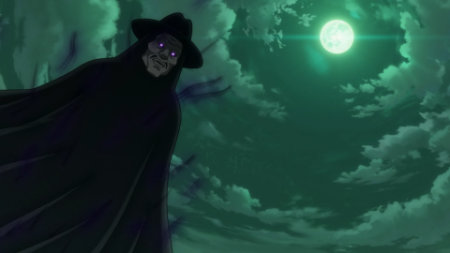 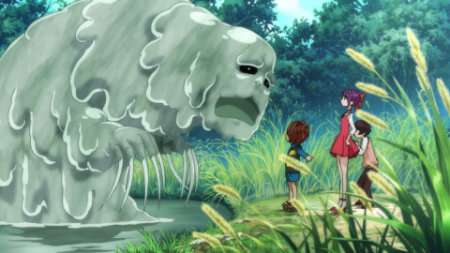 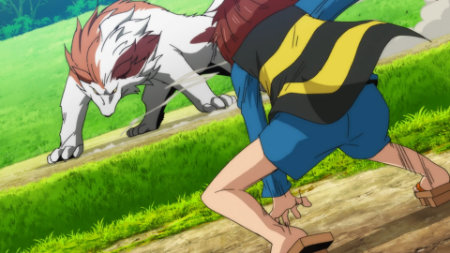 There is also some culture clash involved that goes beyond the whole yokai/human aspect of the show. Once the Backbeard saga rolls around, we are introduced to the western yokai brigade, lead by an eponymous being known as Backbeard. Ruling over a coven of witches, which also includes a vampire, a werewolf and even a Dr. Frankenstein Monster -- yes, that's both characters combined into one, more or less -- who have come to force the eastern yokai under their rule. And they would probably have succeeded too, if not for those meddling kids Mana and Astrid, the latter being the daughter of the woman who seems to lead the whole Brigadoon project designed to bring everything under Backbeard's rule. This is where GeGeGe no Kitaro does a pretty good job in portraying culture clashes in a way that doesn't necessarily alienate either the east or the west, even as it might look like the western yokai will serve as the biggest antagonists. Interestingly, the fact that, for what looks like your average shounen series, there isn't really all that much fighting in GeGeGe no Kitaro. Kitaro appears, he usually does his thing with either his needle hair attack, his remote controlled geta sandals -- or sometimes, if things are serious enough, his finger gun -- and things are usually settled fairly quickly, leaving more time to wax traditional, philosophical or... well, criminal, as people can be sometimes. This is the main reason why I made the Natsume's Book of Friends comparisons earlier in this review. It's... not as much a study of modern culture, granted, and neither an indepth look at the world where the otherwordly hang out, but it serves as a fairly decent starting point if you're so inclined. For this review, I've had to cheat a bit. The episode count/review status is going to say "full", but as the 2018 GeGeGe no Kitaro show isn't quite done yet at the time of writing, I have instead chosen to cover its main arcs, as they are. Granted, the Backbeard arc doesn't really start until episode 27, and the Nanaki saga only goes into full swing after that arc has concluded. Beyond that, GeGeGe no Kitaro follows the same episodical structure as Natsume's Book of Friends, with some later episodes occasionally referring earlier events. The Backbeard saga is the one that's more classical shounen, as the fight between the eastern and western yokai pretty much dominate that arc, and come to a fairly conclusive ending once everything is said and done. The Nanaki arc isn't as much an arc, as the eponymous sinister figurehead appears already in the beginning episodes, but remains more of a background figurehead, manipulating events to his liking until it's time to make his move. The two make for an interesting contrast in classical villains; where Backbeard is prevented from influencing things directly until his Brigadoon project is complete, after which he becomes more of a power player, Nanaki prefers manipulating others from the shadows almost all the way to the end, even though he's a being that is already present in the real world. Not that this means the standalone episodes are any less important, though. Granted, their quality might vary a bit more, but GeGeGe no Kitaro features single episode stories with twist endings, where a manager for a firm that exploits manual labor finds himself on a mysterious train, and the viewers will probably see his end come before he does, but then it turns to a girl who seemingly accidentally filmed his demise when he's seemingly pushed down on the tracks just as the train arrives... and said girl wasn't a very nice person herself, tying into some events that happened early in the episode. But GeGeGe no Kitaro is also not above showing how even good people can make bad decisions; a down-on-his-luck comedy act sees his fame get a resurgence when he accidentally encounters the yokai Sara-Kozo singing a silly song as he's doing his thing, and incorporates that into his comedy act to great success... only to find out that Sara-Kozo is less than forthcoming about people using his song at all! Said comedian isn't a terrible man in any measure of the word, and more than that, he even has a wife and daughter who love him very much and make it quite clear that they don't care he's not famous anymore. But fame, once he had tasted it, isn't as easily forgotten, and the desire to be back in the limelight, even at the cost of one's life, can influence people to make terrible, self-destructive decisions. GeGeGe no Kitaro isn't above telling its audience that even the kindest of people can sometimes make short-sighted, selfish decisions. Not everyone has Rat Man's resilience, after all, so pick your mistakes well when you make them. GeGeGe no Kitaro is in many ways a story about a journey. Among the regulars in the show, it's a journey for Kitaro to understand humans much in the same way that it's a journey for Mana to understand Yokai. As much as it is a story of human folly, it can also sometimes be a story about inflexibility on both the human and yokai side, and how that inflexibility can lead to people making bad decisions, and the only way for people to get past this and learn something from their situations is to learn -- to get to know the other side and trying to see things from their perspective, which is something that takes time. And time, it seems, have become such a valued commodity that few can afford it, but the backpayment for not having that time is usually frustration, anger or even outright hatred. GeGeGe no Kitaro can get dark when it chooses to; bullying, mob culture and needless aggressivity is often the order, situations that only get to develop because the people involved tend to be aggressively inflexible and concerned with mostly themselves. But that isn't necessarily the case all the time; you can be a loving father and a good husband to a wife who loves you with all her heart, but the fall from an earlier fame can be a hard thing to let go of. And when that light at the end of the tunnel comes in the form of a song belonging to a yokai who is very protective of it, and is quite willing to kill whoever else sings it, you aren't going to fail to notice that bad things can happen to good people. All it takes is a desperate human in a society that wants everything right now, all the time, and isn't very generous about second chances. 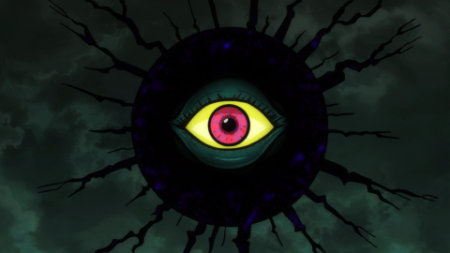 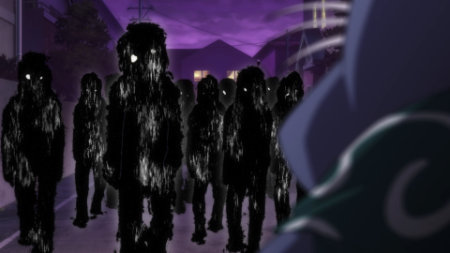 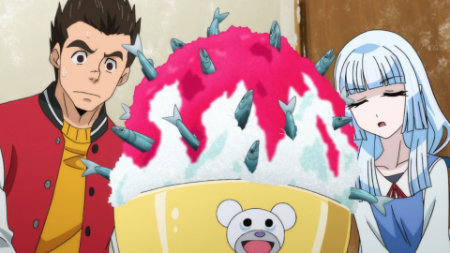 Thankfully, it's not all grim and dark. As unapologetic as GeGeGe no Kitaro can get, it knows very well how important the bonds the show allows to form are. The friendship Mana strikes up with Neko Musume is as endearing as the one she strikes up with Agnes, the western witch girl, and those are opportunities she only gained because Kitaro was willing to give her a chance too, a bond that was no less beneficial to Kitaro himself. And every now and then, you'd also get a sweet little love story between a human and a yokai; although the story between Shun and Yuki -- and yes, of course Yuki is the famed "snow woman" of legend -- does start off a bit iffy on Shun's end, since he seems kind of inconsiderate and loud for the most part, but the episode ends on a hilariously cathartic moment where the two yell at each other about the parts they hate about each other before sharing a shocked look and then breaking down into laughter. It's a slightly unusual end of a slightly usual story of lovers from different worlds, and it was kind of endearing, as well as doing wonders in getting me to warm up to a male lead I didn't much care for at first glance. So.... after episode 49, where do we go from here? Well, on the conclusion of the Nanaki saga, you can look forward to Kitaro visiting the underworld -- or the realm of the dead, where King Enma resides, if you will -- and Kitaro being tasked with a pretty damn high-stakes mission. I will of course look forward seeing where they go from here, and so, I leave this show with a pretty strong recommendation on my end. An almost perfect mix of the old and the new, with some strong character writing and a slight enough deviance from your average shounen formula that it didn't trigger my shounen fatigue. Have fun. — Stig Høgset Recommended Audience: The show isn't particularly violent per se, but it's also not shy about portraying the terrible things that can happen to people when they are irreverent -- or even just unlucky -- enough in their life choices. The fact that it thematically deals with topics like human trafficking and the darker side of prejudice and hatred, or an overreliance on fame and the corpses you walk over to get there, puts it squarely out of reach of the young 'uns. Don't let the potatohead visuals fool you there. Version(s) Viewed: Digital stream on Crunchyroll, Japanese with English subs. Review Status: Full (49/49) GeGeGe no Kitaro (2018) - Episode 1-49 © 2018 Toei Animation. |
 |
|
| © 1996-2015 THEM Anime Reviews. All rights reserved. |